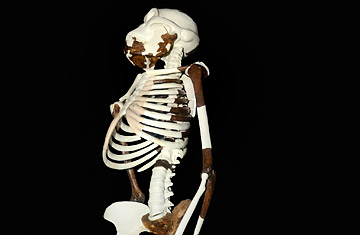
A reconstruction of the skeleton of Lucy, the fossil hominid that was discovered in 1974 in a dried-up lake near Hadar, Ethiopia
The myth that humans are the only tool-wielding animals was laid to rest long ago: chimps, otters and even birds use sticks and stones to leverage their innate abilities. But like so many other attributes we share with other creatures — including communication, thought, emotion and social behavior — we take tool use to an entirely different level.
Starting millions of years ago, the evolutionary ancestors of humans figured out how to use primitive stone tools in a systematic way. For example, they learned how to butcher large animals, which gave them access to a source of food their primate cousins couldn't touch. That's what may have fueled the growth in their brain size, which eventually led to modern humans.
Exactly when that leap took place has never been pinpointed, but the oldest evidence of stone tools has dated back to about 2.5 million years ago — at least until now. In a new paper, released on Wednesday by the journal Nature, Zeresenay Alemseged, an anthropologist at the California Academy of Sciences, and several colleagues say they have pushed that milestone back 800,000 years. Two animal bones, excavated in Dikika, Ethiopia, bear what the authors call "unambiguous stone-tool cut marks for flesh removal and percussion [i.e., smashing] for marrow access."
In other words, some species of human ancestor — likely Australopithecus afarensis, whose best known representative is 3.2 million-year-old Lucy, the authors say — not only had a hankering for meat, which scientists had not expected, but used tools to get it. That demonstrates cleverness, says Alemseged. It also shows that the butchers were capable of complex social behavior. "They're sharing the landscape with dangerous scavengers such as hyenas," he says, "and so some would have had to serve as lookouts." And because that landscape bore only pebbles, not rocks, they would have had to carry the stone tools several miles before using them.
The marks were evident as soon as the bones came out of the ground — one from a large, hoofed mammal about the size of a cow, the other from a goat-size antelope. "The [marks] were clearly V-shaped, which potentially indicated that they were made by tools," says Alemseged.
He and his fellow excavators used a scanning electron microscope to take a closer look. Sure enough, the grooves in the fossilized bones bore fine striations running in the same direction as the cuts themselves — the hallmark of deliberate cutting. The scientists even found a tiny fragment of the tool itself embedded in one of the cuts. Chemical analysis shows that "it was clearly embedded before deposition," says Alemseged, which rules out a random piece of grit having worked its way into the groove later on.
Fortunately for the researchers, the bones were buried in sediments whose age was easily determined; based on a relatively straightforward analysis, the fossils can be dated to between 3.24 and 3.42 million years old, and probably closer to the latter. Because the only hominin known to have lived in that area back then was A. afarensis, the anthropologists believe that's the species that used the tools.
Whether A. afarensis actually fabricated their scrapers or simply used sharp rocks they found lying around is much less clear, since the tools themselves haven't been found. That's not surprising, Alemseged says. "The earliest stages of tool use will probably be less widespread, more erratic," he says.
Alemseged argues that anthropologists should be doing more systematic surveys for animal fossils of this vintage, to uncover further evidence of butchery. Typically, anthropologists look for animal bones only to determine what species of creatures co-existed with human ancestors. But since the two bones Alemseged's team found would not have been useful for that purpose, "you probably wouldn't collect them," he says. "But we made an effort to collect all the bones we found. We need to replicate that strategy, and urge others to do the same."
